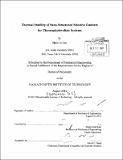Thermal stability of nano-structured selective emitters for thermophotovoltaic systems
Author(s)
Lee, Heon Ju, 1977-
DownloadFull printable version (13.22Mb)
Other Contributors
Massachusetts Institute of Technology. Dept. of Mechanical Engineering.
Advisor
Sang-Gook Kim.
Terms of use
Metadata
Show full item recordAbstract
A fundamental challenge in solar-thermal-electrical energy conversion is the thermal stability of materials and devices at high operational temperatures. This study focuses on the thermal stability of tungsten selective emitters for thermophotovoltaic (TPV) systems which are anticipated to enhance the conversion efficiency. Selective emitters, 2-D photonic crystals, are periodic micro/nano-scale structures that are designed to affect the motion of photons at certain wavelengths. The structured patterns, however, lose their structural integrity at high temperatures, which disrupt the tight tolerances required for spectral control of the thermal emitters. Through analytical studies and experimental observations, the failure modes of tungsten 2-D photonic crystal are indentified. There were four major mechanisms of thermal degradation by which micro/nano-scale structures change their geometry when heated: grain growth and recrystallization, oxidation, surface diffusion, and evaporation. A novel idea of flat surface tungsten photonic crystal (FSTPC) was proposed and was validated by theoretical modeling and by experiments. Pre-annealing or using single crystalline tungsten will prevent the grain growth. A thin layer of diffusion barrier will prevent oxidation and/or evaporation and maintain the optical performance. By filling in the micro/nano-scale cavities with a damascened IR transparent ceramic, the surface of the emitter will have negligible second derivative of the curvature, and thus eliminates the surface diffusion even at high temperatures. Accelerated tests on silicon-based 2-D photonic crystal show that the micro/nano-scale structures on the silicon surface survive for at least 100 hours at 400 °C, homologous temperature of 0.4, which is equivalent temperature of 1200 °C for tungsten. Based on a scale-accelerated failure model, the life time of the Flat Surface Tungsten Photonic Crystal (FSTPC) is estimated to be at least 40 years at 800 °C.
Description
Thesis (Ph. D.)--Massachusetts Institute of Technology, Dept. of Mechanical Engineering, 2012. Cataloged from PDF version of thesis. Includes bibliographical references (p. 97-103).
Date issued
2012Department
Massachusetts Institute of Technology. Department of Mechanical EngineeringPublisher
Massachusetts Institute of Technology
Keywords
Mechanical Engineering.